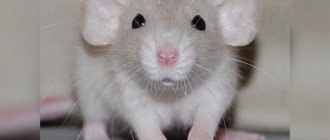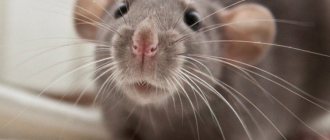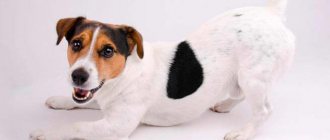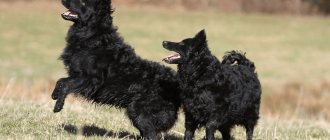The Rex Rat breed owes its birth to a mutation that was accidentally obtained by breeders. The offspring of this hybrid had curly hair. When breeders noticed the unusual fur of rats, they decided to fix the mutated gene and thus created a new species of rat for the world to see.
The Rex breed does not have official status - it is not listed in the standards and is considered a subspecies.
Description of appearance
These animals are unique mainly because of their curly coat. Otherwise they look like other breeds.
It is not difficult to recognize Rex by his appearance. Healthy purebred animal:
- The coat is thick and curly, without bald spots or rosettes;
- The curls on the coat are springy;
- the muzzle is wide and blunt;
- The ears are large and widely spaced;
- fluffy tail.
Subspecies
The breed includes three subspecies. The main one is the breed standard described above. The other two are intrabreed subspecies:
- Dumbo Rex (the variety is named after the famous baby elephant from the Disney cartoon, so the peculiarity of the Dumbo Rex rat is immediately clear from its name - these are large round ears, the fur of the animal does not differ from the breed standard);
- Double Rex (a semi-hairless variety - the rat looks as if it had been shorn, the fur of the animal is very short, sticking out in different directions due to curliness, otherwise the appearance of the animal does not differ from the breed standard).
Appearance of a rex rat
Rex rats were bred on the basis of the Standard breed, their main parameters coincide with this designation, with the exception of the composition and quality of the fur.
The body length of the imago sometimes reaches 27 cm.
Important: The main difference between a Rex and a standard rat is that there is less hair in the coat structure.
Curly rats have a dense coat with evenly distributed curls. They have almost no fluff on their bellies. The fur has a low hair content, so their coat is not as shiny as a standard rat's.
The vibrissae are strongly curled, but have a shorter length compared to the vibrissae of other ornamental rodents. The curly fur of a rat is a little thicker, but not very coarse.
Wavy rexes have fewer curls than curly rexes, but their fur is dense and soft, and appears slightly ruffled from the side. Their dense undercoat has a uniform hairline. They can be slightly longer than curly rats and have a wavy shape. Sometimes there are people with vibrissae that curl at the ends.
These animals are especially charming due to their thin tentacles, which are located just above the eyes.
A purebred rex rat has the following characteristics:
- Thick and curly coat with bouncy curls;
- wide, slightly blunt muzzle;
- large, widely spaced ears;
- The bushy tail is also a characteristic of the breed.
Rat fur has a plush softness. Children are born curly if both parents have the curly hair gene. Rex puppies always have a somewhat disheveled appearance - over time, their undercoat begins to fall out and hairless spots form, but these are quickly replaced by new hair.
Interesting! There are mongrels of this breed. Red and black or red and ruby color combinations are not considered a defect. They can occur in animals with any marking.
How to extend your pet's life
Based on the fact that the average lifespan of a rat is 2 years, you can try to increase this period by surrounding the animal with attention and care
Disease Prevention
It is easier to prevent the cause of the disease than to deal with the consequences. Proper care will avoid many problems. The rat cage should be cleaned and washed regularly using a weak disinfectant solution. The water in the drinking bowl must be clean and changed every day. It is better to use regular filtered water. You should regularly remove food debris that is decomposing and can cause illness.
Avoid pine filler
. It is not suitable for rodents. You can use corn or simply lay toilet paper for the animals.
Don't overcool your pet
. Drafts and improper placement of the cage can cause a cold.
Place the newly acquired animal separately in quarantine so that it does not infect the old inhabitants of the cage. Purchase an ultraviolet lamp to disinfect the room. Find a veterinarian who specializes in rodents to contact if you are sick.
Health monitoring
The habit of observing your pets will allow you to learn a lot about them, and at the same time notice the signs of an incipient disease. If the animal is not eating well, has stopped playing, looks lethargic, or has discharge from the nose or eyes, and its fur has become disheveled and unkempt, consult a doctor immediately. Infectious diseases occur very quickly in rodents, so there is a risk of losing the animal. Diarrhea not associated with an excess of vegetables also indicates illness.
Inspect your pet's stool, it may contain helminths - worms. You should be wary of the fact that the rat itches intensely - there is a risk of parasitic diseases. A rodent dragging its hind legs also requires attention - this is a common problem for aging rats. Older animals are susceptible to tumors, heart attacks and strokes.
Conditions of detention
How many years domestic rats live is directly related to their living conditions. This is affected by:
cage size - at least 60x40x50 cm (width-length-height) for 2 animals, and for females it is better to make high multi-level cages, and for males the floor area is important; cage equipment – hammocks, shelves, etc.; neighborhood - rats are pack animals, so it is better to keep two, three, but no more than four same-sex animals together; the possibility of walking on a fenced area or on a sofa; sports activity in the form of an obstacle course in the play area; owner's attention. Rats are gentle creatures that become attached to humans; security of space - shelter, as a prevention of stress.
If a pet rat lives in such a room, and even with regular walking, then this helps it maintain health and good mood
If a pet rat lives in such a room, and even with regular walking, then this helps it maintain health and good mood.
Proper nutrition
A balanced diet of grains, small amounts of fruits and vegetables with the occasional addition of protein will allow animals to feel good. You cannot feed animals table food or overfeed them with high-calorie foods. To prevent dental diseases, you need to keep a mineral stone in a cage to grind down your incisors.
If a decorative rat lives comfortably at home, then it has a greater chance of reaching a “respectable” age. Although a pet's lifespan is short, it will fill the owner's life with vivid impressions and deep affection.
Previous Features and habits of ratsHow many hours do domestic rats sleep per day Next Features and habits of ratsWeight and size of rats from small to adult - table by age
Features of maintenance and care
If you are planning to buy a Rex rat, you will need to get equipment for breeding this animal:
- Spacious cage.
- Food bowls.
- Separate shelter house. It is better if it is made of hardwood.
- Swing.
- Hanging toys, hammock.
Your pet's cage should be cleaned weekly. Disinfect the cage once a month. It is very important for your pet to have a clean home and always have fresh water in it. You can pour it into a bowl or buy a boozer from a pet store.
It is better to feed the animal in the evening, but part of the daily ration can be given in the morning. The most common question about caring for frizzy rats (fly rats) is the specifics of their diet. Experts recommend taking ready-made formulas as the basis of a rex's diet. It is necessary to add vitamins, grains, fruits, and herbs to them. A rat eats 15-20 g of food per day.
If the rodent's diet consists mainly of natural food, it should include:
- semi-finished products;
- fresh apples;
- leaf salad;
- pieces of boiled chicken meat;
- boiled eggs;
- seeds;
- sour cream;
- kefir;
- fruits and dried fruits.
Important: You can treat your pet with unsweetened breadcrumbs from time to time, especially during training.
Nutrition
The rat diet should be based on ready-made food. Mandatory feed additives include cereals and vitamins. You can feed your pet with the following:
- half-boiled porridge;
- fruits (especially apples and plums);
- greens;
- boiled lean chicken;
- boiled eggs;
- fruits;
- seeds;
- sour cream;
- kefir
Unsweetened crackers can be given as a treat.
Character and nicknames
These rats are less active than their other relatives. They quickly get used to their owners and become tamed. This rodent can quickly get used to its name and return to its cage at the first call.
When choosing a name for your rat, try to make it sound and simple, because rodents do not tend to remember long words. Ideally, the name should contain consonants so that the animal can more easily perceive it by ear. For example, the female can be called Goldie, Bonya, Dina, Lala, Sonya or Ollie, and the male can be called Ballou, Winnie, Teddy, Pete, Shonya, Duck or Tosha.
After some time, the dam will learn to respond to the sound of your voice and will run towards you. If you plan to let him outside to run around, you will need to hand train him first before returning him to his crate. When training a rodent, remember that he is not a dog, so be patient.
If you have problems
The Rex breed is an excellent choice for those who dream of having a beautiful and funny animal. Such pets charm with their playful disposition and become attached to their owner. You'll never get bored with them! But what if the rodent suddenly gets sick, becomes sad or loses its appetite?
In this case, the best solution would be to go to the veterinary clinic. Experienced specialists are well versed in the characteristics of all breeds and will give you many valuable recommendations.
Description of the breed
The Dumbo rat differs from the typical ornamental pattern of the rat breed by having low, rounded ears; the larger the ears, the more valuable the specimen of the breed. The breed was named after the adorable little elephant, beloved by children all over the world, of the same name.
Dumbo is a Disney cartoon character known for his huge round ears. Ratatouille is another smart and cute cartoon character from this movie studio and a representative of the Dumbo ratbo decoration.
Dumbo (Mickey Mouse)
They differ in the structure of the skull and the shape of the ears, which are located not on top of the head, but below. As a result, the animal's head appears slightly flattened and expanded. The ears are round and elongated.
These rats come in two varieties - completely open and with slightly curved edges. There may be specimens with a slightly protruding neck, although this is usually barely noticeable. The animal's body shape is slightly wider at the back, but the size is smaller than other breeds.
Longhair
Long-haired varieties of rats differ from standard ones in that they have longer hair.
Sphynx (hairless) rats
There may be drooping on the head, paws and groin area. Typically, rodents have pink skin in folds, but there are individuals with dark spots. The vibrissae of this species are shorter than those of the standard species and can curl.
Decorative sphinx rats should be protected from both cold and overheating.
Downy (fuzz)
Furry rats are similar in appearance to sphinxes, but the “hairy” rat gene is at work. The skin of pheasants is covered with down - there are no downy hairs. The hair is longer on the face and lower body. The mustache is short and curved.
Unlike sphinxes, furry animals are valued more “dressed.” Fuzzy is more hardy than sphinxes and is easier to hatch. However, a thin bladder does not always protect against overheating or cooling, so animals require special attention.
Dazzling rats have beautiful fur - not full-fledged “clothing”.
Rex (curly)
The coat is similar to that of a cat of the same breed - it is hard and curly. Elastic curls do not appear immediately. Rats have not yet developed curls, and the hair can stick out in different directions.
This is the reason why babies look dirty. According to the breed standard, the coat should be uniform, without bald spots. These animals have short curly whiskers. In other cases, Rexes are similar to the standards.
Rex babies sometimes look disheveled.
Double Rex
Such rats are born when mom and dad are carriers of the “curly” gene. The fur of such animals is unusual. The fur has fluffy patches and coarse, spindly hairs.
Another feature is shedding. Since childhood, rats lose their fur, and the fur coat resembles a patchwork quilt. The hair areas alternate with partridges. Later, hair grows in bald areas and falls out in the “hairy” areas. Double rexes are not officially recognized as a species.
Double rex rats have fur covered in patches.
Satin (satin)
Satin or satin rats are distinguished by a thin, shiny coat. Glossy fur gives animals an attractive appearance. A thin layer makes the hair visually longer. Satins can have a short coat like the standards. Long hair does not define this variety: not every long-haired rat is a satin.
The satin or satin rat is covered in fine, glossy fur.
Manx
This species of rat does not have a tail, so it is not particularly valued as it is considered handicapped. The fact is that most of these rats have problems with their hind legs and urinary system. These animals can be of different colors. Their fur can be wavy and curly.
Standard
Animals of this type have a standard design. They are slender and agile. The animal's tail is almost the same length as the entire body and head. The eyes are large and shiny, round in shape, their color is in harmony with the color of the fur coat according to the standard.
Small, well-shaped ears are located at the top of the head. The rodent has hair all over its body, it is shiny and well attached. There is short hair on the legs and tail.
Light-colored animals have a short, velvety coat on their ears. They have long and proportional whiskers located on their cheeks. They also have whiskers above their eyes, but they are much smaller and shorter there.
Rodents with other types of fur have short, sparse and curled whiskers. Standard rats are considered the largest among decorative rodents and can weigh up to 500 grams.
What affects life expectancy
Dumbo rats are unpretentious, so they have managed to adapt to living conditions in many countries. At minimal cost, owners get a cute pet with an easy-going character and extraordinary intelligence.
Conditions of detention
Rats feel great in small cages (60x40x60cm) with metal bars. The cage must have:
- deep plastic tray;
- solid bottom;
- wide doors;
- shelves;
- stairs;
- ropes.
The Dumbo family is very friendly, so several rodents can easily fit into the cage. Together they feel completely comfortable: they do the cleaning and brush out the fur.
A small house inside the cage will add comfort to the Dumbo rats. Babies love to retire and take a nap in silence. Adult pets will appreciate a warm hammock; they will be happy to spend their leisure time there.
Wood or corn filler will help eliminate the specific odor from the rat family. Sometimes owners try to lay napkins or toilet paper on the bottom, but this option is not suitable for rats. Regular cleaning will also help keep the cage clean. Twice a week it is necessary to remove leftover food and used filler, change the water in the drinking bowl, and carry out disinfection.
Dumbos at home should live in a warm room where there are no drafts and moisture. Rats are very sensitive to sharp sounds, blinding light, and overheating. They get tired of people's annoying attention.
Diet
Dumbo rats, unlike rodents that live in the wild, are very sensitive to the consumption of low-quality food. Poor nutrition can easily provoke gastrointestinal disorders and allergies, so owners will have to create a diet according to certain rules.
The rat's menu must include:
It is strictly forbidden to give Dumbo rats fatty and fried food from the master's table, alcohol, sausage, sprouted potatoes, green bananas. The quality of the food should not be in doubt, otherwise the pet will become ill.
Young rats are fed 3–4 times a day. Adult pets need only two meals a day.
It is important to remove uneaten food debris so that the rodent does not eat spoiled pieces.
Hygiene
Dumbo rats are real clean people. They clean their fur and wash themselves, so you don’t have to bathe them often. Water procedures will be required if the pet gets very dirty. Rats, unlike other pets, love to swim. They can splash around in warm water for a long time.
Bathing is carried out with special shampoos in a warm room without drafts. It is necessary to ensure that water does not get into your pet’s ears, which can lead to hearing loss. After bathing, the rat is wrapped in a warm towel and dried well. If the room is cold, it is better to dry the fur with a warm stream from a hairdryer.
One of the dangers of swimming is hypothermia. A frozen rat can easily catch a cold. Therefore, in the cold season, the doors and windows in the room are tightly closed, and a heater is placed near the cage.
Entertainment
Caring for and maintaining Dumbo rats means not only food and a cozy home, but also a kind of gym. In the absence of the owner, the animals entertain themselves by climbing ropes and rope ladders, and passing through tunnels. Some craftsmen make toys for pets on their own.
Important Features
The breed was bred in California laboratories in 1991, and in the 2000s such creatures were brought to Russia from England.
If you are wondering how long do dumbo rats live, then know that these rodents have a lifespan of three years.
The breed grows up to 20 centimeters. Females weigh from 200 to 400 grams, and males from 250 to 500 grams.
Character and life expectancy
The character of Dumbo rats is very friendly; affectionate and trusting animals quickly get used to their owners, remember their nicknames and are easy to train.
Dumbo rats become very attached to their owners.
Young rodents of this breed are more active than their cousins, they enjoy fun and active play with people and other rodents, older animals like to lie on their owner's lap or sit on their shoulder. This breed is very clean, neat and well accustomed to the litter box.
The average life expectancy of rodents of this breed is 2-3 years.
The lifespan of Dumbo rats in a home directly depends on the quality of housing and food. With proper care, timely treatment of rat diseases and feeding a balanced diet consisting of protein and fat with the addition of greens, vegetables, fruits and vitamins, the life of pets is extended to 4-5 years.
Breeding history and appearance
Dumbo rats look very funny and touching because of their large and disproportionate ears with a small head, which makes many people emotional. This breed is especially loved by young children for its attractive appearance.
Dumbo with pointy ears
Dumb rats have two types of cute ears: flat, round, saucer-like ears, or slightly pointed, reminiscent of a half-open tulip bud with a curved petal, the pointiness is slightly pronounced.
When the latter ear variant is pressed from behind, the pinna opens and the regular rounded outline of the ear is visible, Dambo rats with this ear variant are widespread in European countries.
Dumbo with round ears
American scientists bred decorative dumbo rats in the laboratory in 1991 in California, but only 10 years later the charming rodents found their way to Russia.
Despite the popularity of pets with large ears, it is difficult to find rats with clear breed characteristics. The big ears gene is recessive, so it doesn't appear in every litter of rats, even if the parents have particularly large, round ears.
Animals with ears without identifying species are still considered ornamental dumbo rats and can produce adorable babies with adorable round ears.
The body length of animals of this breed does not deviate from standard parameters: males grow to 18-20 cm and weigh 250-500 g, females reach 15-18 cm and weigh 250-400 g.
These rodents have a more pear-shaped short body compared to ordinary decorative rats, and the lower part is more developed than that of the standard breed. The Dumbo breed can have a standard body type, like regular domestic rodents.
The dam's skull is flatter and wider than that of other ornamental rat species, with a relatively pointed snout. The forehead is slightly prominent, but not hunchbacked, and the eyes are large, round and located on both sides of the head. The Dumbo breed has a longer tail than the standard domestic rat.
Colors
Dumbo rat, amber in color. The color of this breed, as well as the length and quality of the coat, can vary greatly within the species. Individuals with short, velvety straight hair are most often found in grey, white, black and chocolate colors. Rare Dumbo rat colors are considered Siamese, Amber, Topaz and Mosaic (Tricolor).
Dumbo rat, tricolor
Incredibly beautiful blue mink rat-dumbo. Can be found only from large breeders, at a fairly high price for decorative rats.
Blue Mink Dumbo Rat
By crossing dam rodents with decorative rats of other breeds, scientists managed to obtain a new subspecies that deserves the attention of amateur breeders.
Dumbo rat, topaz color
Use in research
Dissection of a laboratory rat
The rat found early use in laboratory research in five areas: W. S. Small proposed that speed of learning could be measured by using rats in a maze; sentence used by John B. Watson for his Ph.D. defended his dissertation in 1903. The first rat colony in America used for nutrition research was founded in January 1908 by Elmer McCollum, and the nutritional requirements of rats were subsequently used by Thomas Burr Osborne and Lafayette Mendel to determine the details of protein nutrition. Reproductive function in rats was studied at the Institute of Experimental Biology at the University of California, Berkeley by Herbert McLean Evans and Joseph A. Long. The genetics of rats was studied by William Ernest Castle at the Bussey Institute at Harvard University until it closed in 1994. Rats have long been used in cancer research; for example, at the Crocker Cancer Research Institute.
A rat passes the morris navigation test
The species' historical importance to scientific research is reflected in the amount of literature about it: approximately 50% more than that for laboratory mice. Laboratory rats are often subjected to necropsy or microdialysis to study internal effects on organs and the brain, such as for cancer or pharmacological research. Uneuthanized laboratory rats may be killed or, in some cases, become pets.
A rat is deprived of REM sleep using the flowerpot technique
Domestic rats differ from wild rats in many ways: they are calmer and bite much less frequently, they can tolerate larger crowds of people, they reproduce earlier and produce more offspring, and their brains, livers, kidneys, adrenal glands and hearts are smaller.
Scientists have bred many strains or “strains” of rats specifically for experimentation. Most are derived from the albino Wistar rat, which is still widely used today. Other common strains are the Sprague Dawley, Fischer 344, Holtzman albino, Long-Evans and Lister black rats. Inbred strains are also available, but are not commonly used as inbred mice.
Most of the Rattus
has been sequenced. In October 2003, researchers were able to clone two laboratory rats using nuclear transfer. This was the first in a series of developments that began to make rats suitable for genetic research, although they still lag behind mice, which are more amenable to embryonic stem cell techniques that are commonly used for genetic manipulation. Many researchers who want to trace observations of behavior and physiology back to underlying genes find aspects of them in rats to be more relevant to humans and easier to observe than in mice, giving rise to the development of genetic research methods applicable to rats.
A rat traverses difficult terrain under the influence of electrodes fed into its brain.
A 1972 study compared tumors in Sprague Dawley rats from six different commercial suppliers and found highly significant differences in the incidence of endocrine and mammary tumors. There were even significant differences in the incidence of adrenal medulla tumors among rats from the same source bred in different laboratories. All but one testicular tumor occurred in rats from a single supplier. The researchers found that the incidence of tumors in Sprague-Dawley rats from different commercial sources varied as much as in other strains of rats.
The study authors "emphasized the need for extreme caution when evaluating carcinogenicity studies conducted in different laboratories and/or in rats from different sources."
During food rationing due to World War II, British biologists ate lab rats with cream.
Features of home maintenance
The rat needs a big house where it can run freely without limiting its play time. Due to the high sociability of this species, it is recommended to have several individuals at the same time.
If only one curled up rat can be kept, its cage should contain:
- Swing;
- house;
- climb;
- various entertainments.
Animals are omnivores, but for good health it is necessary to supplement the diet: ready-made industrial feed, vitamins and cereals.
The Rhesus rat's cage should be equipped with entertainment devices.
These animals are easy to care for: just change the food regularly and clean the cage daily. Twice a month their “apartment” must be disinfected. Experts recommend feeding in uneven portions, leaving a large portion for the evening.
Clean water should be available at all times, and then the playful pet will entertain the owner with fun games every day.
Choosing a name for the rat Dumbo
Owners want to give intelligent puppy Dumbo a deep and meaningful nickname in hopes that the pet's name will influence the funny pet's personality and intelligence. Sometimes it can be difficult to immediately name a pet with a suitable name that emphasizes its individuality and expresses the love of its owner.
It is recommended that you take a few days to take a closer look at the habits and character traits of the new family member; most likely, he himself will tell the owner what to call him. The baby's furry name can be associated with the color and funny ears of a rodent, human associations and funny faces of a pet, favorite book and cartoon characters or pop stars. The rodent's name should be simple and easy to pronounce in lowercase letters. It is believed that females respond best to nicknames beginning with the letters K, M and D. Males prefer names with the letters C, K, M and D, animals with ears are more willing to get used to nicknames with the letters T, H, L, M , K, S, W and R.
The name for dumbo rat girls can be: Knop, Scully, Masya, Dana, Molly, Ksyusha, Martha, Alice, Dasha, Klava, Matilda, Gina, Darcy, Alpha, Kayla, Linda.
The name of a stupid rat can be: Kuzya, Tyson, Tim, Rocky, Simson, Garik, Steve, Venya, Bucks, Rocky, Dick.
It doesn’t matter what the owner calls the smart and eared guy. In any case, the stupid rat will sincerely adore and faithfully wait for its beloved owner, giving him his incredible tenderness and selfless love.
Vaccination
Decorative rats do not need vaccination. No drugs have been developed for them to help prevent the development of diseases in these animals.
Selection and accessories for your pet
An animal's cell must contain several elements:
- drinking bowl;
- feeder;
- nest (place to sleep);
- a mineral stone on which the animal will grind its teeth.
To prevent the animal from getting bored, toys are placed in the house. Rats are very fond of such a device as a hammock. It can be made from a piece of durable fabric or purchased ready-made at a pet store.
Most preferred toys:
- ladders, including rope ones;
- tunnels;
- labyrinths.
Feeding
These pets are quite unpretentious in their choice of food, but are not omnivorous, like ordinary ones. Decorative rats are very gentle creatures, often having problems with the intestines and allergies.
- grain base - it is better to purchase a special mixture for rodents in pet stores. It should make up 60% of the total diet. You can also feed with unprocessed pumpkin, flax or sunflower seeds;
- proteins - occasionally (1-2 times a week) give a little meat (raw or boiled), chicken, yogurt, cottage cheese, eggs will benefit your pet;
- herbs - parsley, cilantro, dandelion, dill, plantain, radish tops;
- vegetables and fruits (preferably boiled) - apples, bananas, carrots, white cabbage, cucumbers, tomatoes, pumpkin, eggplant, potatoes. Citrus fruits must be treated selectively - they can cause allergies in your pet;
- delicacies - grain sticks, nuts, dates, berries, dried fruits, raisins, crackers (unsalted only), unsweetened cookies, boiled pasta, boiled shrimp and seafood.
Reproduction
How to determine gender?
Males can be distinguished from females by their enlarged testicles, which are clearly visible already at the age of 2–3 weeks. In female decorative rats, the rudiments of nipples are observed during this period of life.
Mating
Sexual maturity occurs early - at the age of 5–6 weeks. But individuals from 8 to 10 weeks are recommended for mating. In order to get offspring, it is enough to leave the male and female in the same cage for a couple of days. But you need to understand that fertilization is possible only if the female is in heat. It occurs regularly at intervals of 4–7 days.
Pregnancy
From the moment of fertilization to the birth of rat pups, no more than 23 days pass. On average, birth occurs between 21 and 23 days. The female's pregnancy becomes noticeable starting from the second week after fertilization. The animal’s physique plays a big role in the appearance of the first signs. If the female is thin, the rounded tummy will be noticeable faster than in a fat and large rat.
A litter can contain from 8 to 15 pups. During pregnancy, the female needs increased and nutritious nutrition. Bloody discharge and the female's desire for privacy will indicate the approaching birth . Often the dumbo rat begins to prepare its nest: it cleans and arranges it. Childbirth lasts no more than 3 hours.
How to care for newborn rat pups
The female Dumbo takes good care of her offspring.
During this period, the owner must follow several rules:
- do not pick up baby rats;
- take care of the cleanliness of the cell;
- provide the mother with good nutrition.
Rats can be handled once they are 14–15 days old.
Relationships with other animals
Rats are very friendly towards other animals
Decorative rats have a friendly character . They easily get to know other animals and do not show any aggression towards them. In terms of the level of mental and intellectual development, these rodents are equated to cats and dogs. But whether pets become friends depends not only on the rat, but also on the character of the other animal.











